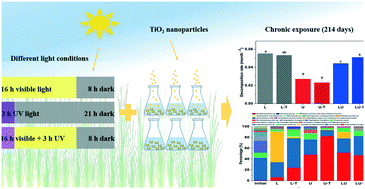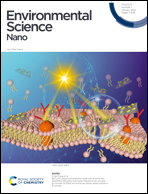How do visible and UV light affect the structure and function of leaf-associated aquatic fungal communities polluted by TiO2 nanoparticles?†
Abstract
Most intensively studied nanoparticles (NPs) possess photocatalytic activity. However, knowledge of the ecotoxicity of TiO2 NPs in response to the natural photoperiod remains scarce. To increase our understanding of the phototoxicity of TiO2 NPs toward aquatic fungal communities, regarding their structure and functioning, a microcosm experiment was conducted involving narrow-leaf cattail (Typha angustifolia) leaf decomposition with TiO2 NPs (50 mg L−1) under different light conditions (visible light, UV light, and the natural photoperiod) for 214 days. Although different light conditions led to significant variations in leaf decomposition, the decomposition rate was not significantly affected by TiO2 NP exposure under either visible or UV light, and it even increased by 15.19% under the natural photoperiod. During the ecological process, significant decreases were observed in the fungal biomass, overall microbial activity, and some extracellular enzymatic (cellobiohydrolase and polyphenol oxidase) activities. Also, TiO2 NPs under visible light and UV light reduced the fungal community diversity and led to the selection of some tolerant fungal species (e.g., Anguillospora longissima) that performed poorly in leaf decomposition under chronic exposure. The information provided here will help us to deeply evaluate the ecotoxicity of nanoparticles on freshwater ecosystem functioning under ambient light conditions.



 Please wait while we load your content...
Please wait while we load your content...